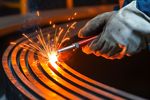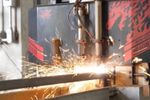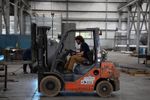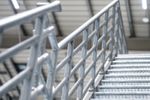Hot-dip galvanizing has long been considered the technique of choice for preventing corrosion of steel products produced via industrial metal fabrication.
Galvanization has been proven effective in harsh conditions for a vast number of products. And although its lifespan will vary according to the product and conditions it is exposed to, it is generally accepted that galvanized steel will last 30 times longer than bare steel.
Today, improved technology and chemistry combine to make hot-dip galvanizing an even more valuable part of industrial metal fabrication. The process not only adds to the longevity of steel products but it has a low initial cost, is readily available, and can improve the appearance of steel products.
There are considerations that both a custom metal fabricator and designer should be aware of, however, as parts are prepared for galvanization. Keeping these considerations in mind will help ensure a successful industrial metal fabrication project.
Bending
It is most common for a custom metal fabricator to bend steel before it is galvanized. However, in some instances, galvanized steel must be bent to fit following galvanization. Bending after coating can be problematic as it can cause cracking in the bend area in some cases, although this cracking can often be repaired.
Bolts, Nails & Fasteners
Because hot-dip galvanization is metallurgically bonded to steel, it actually becomes part of the steel. This is far superior to a coating, especially when it is used for bolts, nails, and fasteners. Hot-dip galvanizing assures the complete coverage vital to the long-term performance of these fasteners.
Dulling
Galvanized surfaces initially are shiny and will dull over the course of time. While many desire the shinier qualities of galvanized steel, if a duller finish is required, contact your industrial metal fabrication specialist for galvanized finishing options that display the desired luster.
Masking
In some instances, it may be desirable not to have an entire surface galvanized. This can be done through masking or covering the surface to prevent its galvanization. Masking can be accomplished through high-temperature tapes, paints, greases, or even water-based pastes.
This is not an exact process, however, and the area that is to be left unprotected may still need some grinding. In some pieces, grinding may be simpler than masking and grinding.
Material Handling
One important consideration when designing industrial metal fabrication products that will be galvanized is understanding if the goal is complete coverage. If so, by including lifting points in the design, coverage of the product itself can be completed without leaving marks from chains or slings. These lifting points can be incorporated into the design permanently or temporarily.
Moving Parts
The galvanizing process can freeze moving parts such as drop handles, shafts, and hinges, so it is important that each part is galvanized before assembly. This will ensure metallurgical bonding occurs to each piece but not to each other.
Surface Condition
To inhibit corrosion, all surfaces must be coated with zinc. If the surfaces are not clean before coating, the metallurgical bond will not be complete.
This cleaning is generally done by immersing the product in a chemical pre-treatment bath. In some instances, however, when paints, welding slag, or sand are present, abrasive blasting may be necessary. This blasting is generally not effective, however, in small crevices or interiors of piping.
Warping & Distortion of Steel
When designing a piece for galvanization, a designer must keep in mind that the piece will be exposed to varying temperatures during the process. These temperature changes will also occur during immersion and withdrawal from the bath.
Designing surfaces with symmetrical designs and sections of similar thicknesses will minimize the potential for warping and distortions in the steel. On the other hand, when thin-walled or asymmetrical surfaces are galvanized, temporary bracing can provide protection against warping and distortion.
Welding
To make sure galvanization occurs at an even thickness, galvanizing after welding is the preferred option. However, that is not always desired. In the case of very large products, it may not even be possible.
When welding after galvanization is desired or required, the materials used for welding and the filler should be monitored to be compatible with the base steel. This will ensure a higher quality weld. The weld can then be protected from corrosion using the procedures in ASTM A780.
Work with Experts at Industrial Metal Fabrication
Southern Metal Fabricators has been serving the industrial metal fabrication needs of a variety of industries from our facilities in Albertville, Ala. since 1991. During that time, we have assisted companies in the design and fabrication of many industrial metal fabrication projects that required galvanization, including industrial staircases, silos, and ductwork.
From design through fabrication to finishing, we can help make sure your project is completed properly the first time. Call us at 1.888.421.9661 or contact us so we can assist you in determining the very best process for your industrial metal fabrication project.





